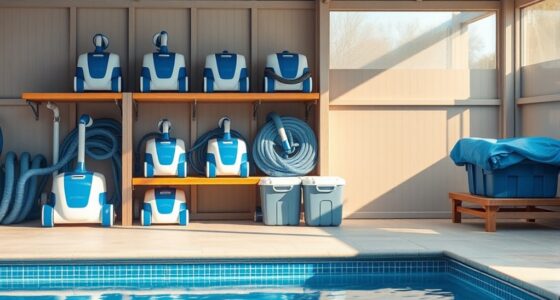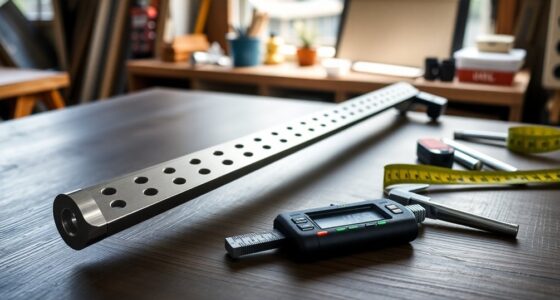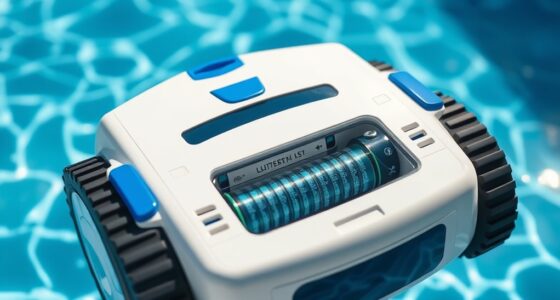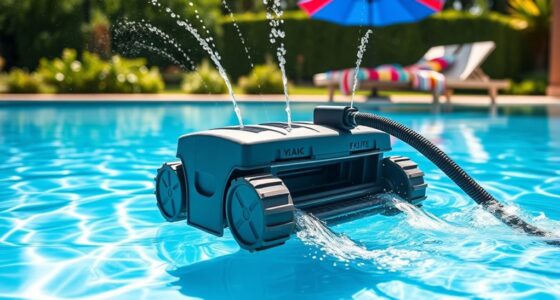To extend your pressure pool cleaner’s lifespan, regularly inspect and clean it, promptly replace worn parts, and store it properly in a dry, protected area. Maintain correct water pressure and flow by checking valves and filters often. Use appropriate accessories and follow manufacturer instructions for maintenance and settings. Consistent routines and proper storage help prevent damage and guarantee peak performance—keep these tips in mind if you want your cleaner to last longer.
Key Takeaways
- Regularly inspect and replace filters, hoses, and worn parts to prevent damage and maintain optimal performance.
- Store the cleaner in a dry, UV-protected area to reduce degradation from environmental elements.
- Follow manufacturer guidelines for routine cleaning, calibration, and maintenance schedules for longevity.
- Monitor and adjust water flow and pressure to avoid unnecessary stress on components.
- Use appropriate accessories and modify settings based on pool conditions to reduce wear and enhance efficiency.
Regularly Inspect and Clean Your Cleaner
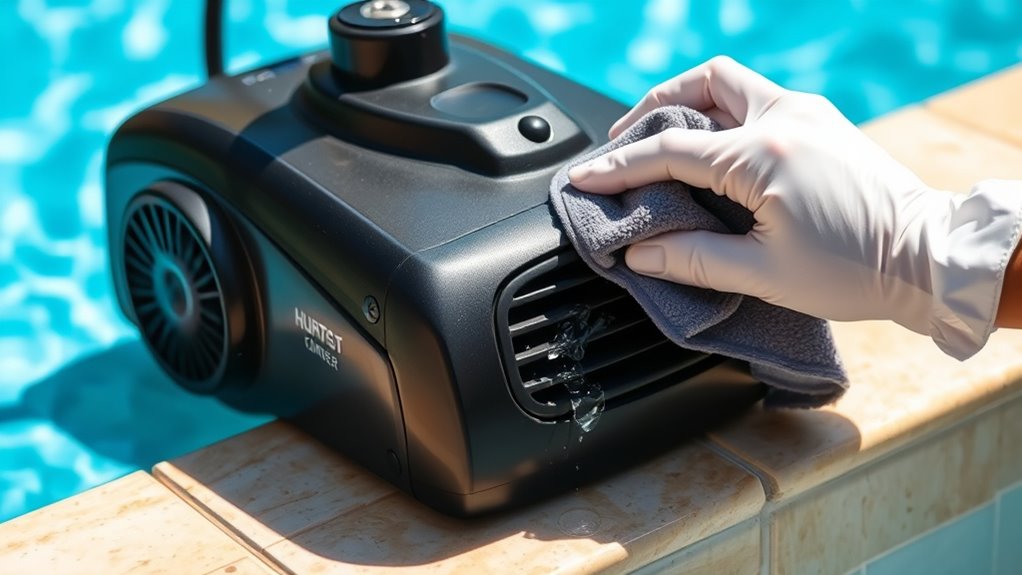
To keep your pressure pool cleaner working efficiently, you should regularly inspect and clean it. Start by checking the filter; if it’s dirty or clogged, replace it promptly to maintain maximum suction and dirt removal. Remove debris like leaves, twigs, and dirt from the cleaner’s intakes and brushes to prevent blockages that can hinder performance. Regular debris removal ensures your cleaner moves smoothly and saves you energy. Also, examine hoses and connections for leaks or damage, fixing any issues immediately. Cleaning the filter and removing debris not only improves cleaning efficiency but also extends the device’s lifespan. Incorporating preventive maintenance into your routine can help identify potential issues early and avoid costly repairs. Performing these inspections weekly, especially during heavy pool use or after storms, can help catch problems before they escalate. Additionally, keeping an eye on pressure levels can indicate when parts may need servicing or replacement. Regularly checking for wear and tear can further prolong your cleaner’s life and ensure optimal operation. Staying proactive with your maintenance can also help prevent clogging issues that might reduce cleaning effectiveness. Proper maintenance is essential for maximizing your cleaner’s lifespan and performance.
Store Properly During Off-Season
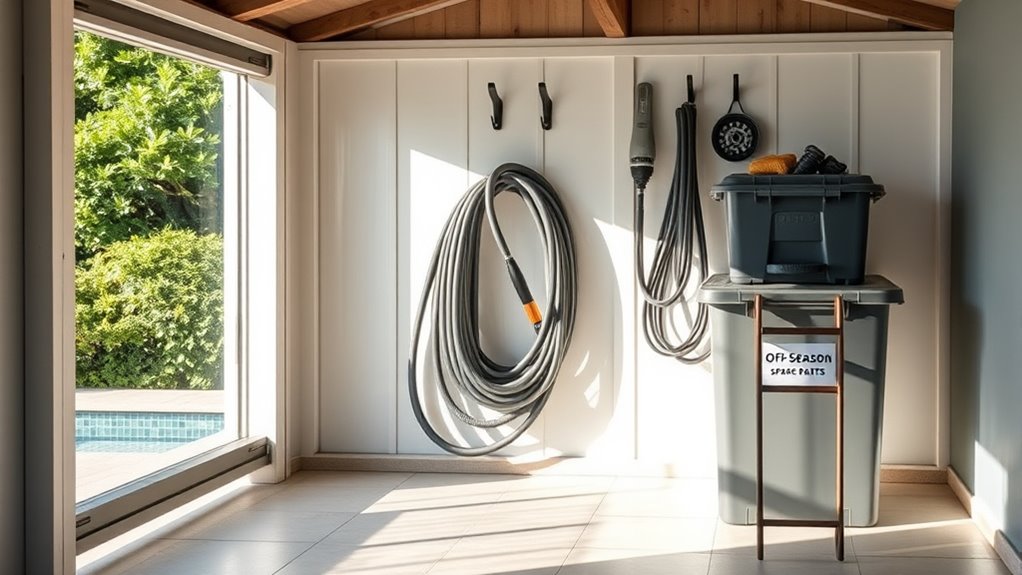
When you’re done using your pressure pool cleaner for the season, make sure to store it in a dry area to prevent rust and damage. Keep it out of direct sunlight to avoid deterioration of the parts and hoses. Proper storage helps guarantee your cleaner stays in good shape and is ready for next season. Additionally, professional equipment is essential for ensuring your cleaner remains in optimal condition during storage. Regular maintenance and proper handling can further extend the lifespan of your pressure pool cleaner, especially as advancements like AI-enabled tools improve maintenance routines. Ensuring your storage area complies with fire safety standards can also help prevent accidents or damage. Incorporating automation in business techniques, such as smart monitoring systems, can assist in maintaining optimal storage conditions and detect potential issues early.
Store in Dry Area
Properly storing your pressure pool cleaner during the off-season helps guarantee it stays in good condition and performs well when you need it again. To do this, keep it in a dry, well-ventilated area away from moisture and humidity. Use cover storage to protect it from dust and dirt. Make certain the storage space maintains temperature control, avoiding extreme heat or cold that could damage components. Consider these tips:
- Store in a dry, elevated area to prevent water exposure
- Use a breathable cover to keep dust off
- Maintain consistent temperature to prevent material warping
- Avoid direct contact with sunlight or moisture sources
- Proper maintenance techniques ensure your pressure pool cleaner remains in optimal working order during storage. Additionally, understanding storage best practices can help extend the lifespan of your equipment.
Protect From Sunlight
Since prolonged exposure to sunlight can degrade your pressure pool cleaner’s components, it’s essential to protect it from direct UV rays during the off-season. UV protection prevents plastic parts from cracking and rubber seals from deteriorating. To maximize shade coverage, store your cleaner in a shaded area or use a cover that blocks sunlight. This simple step extends the lifespan of your equipment and maintains its performance. Additionally, ensuring proper storage methods can further safeguard your equipment from environmental damage. Proper planning can also help you avoid costly mistakes that could impact your investment and long-term use. Using a quality cover specifically designed for pool equipment can provide extra protection from UV rays and harsh weather conditions. Incorporating AI-driven solutions in maintenance routines might also optimize your equipment’s longevity.
Check and Replace Worn-Out Parts Promptly

Regularly inspecting your pressure pool cleaner for worn-out parts guarantees it operates efficiently. Performing routine checks helps you spot issues early, preventing further damage. When you notice cracks, tears, or corrosion, it’s time for parts replacement. Promptly replacing worn-out components extends your cleaner’s lifespan and maintains peak performance. Keep an eye on:
Regular inspections prevent damage and ensure your pressure pool cleaner works efficiently.
- Hoses and connectors for leaks or damage
- Brushes and scrubbers for excessive wear
- Drive belts for fraying or slack
- Nozzles for clogs or erosion
- Regular maintenance, including filter cleaning, can help prolong your cleaner’s overall durability. Additionally, understanding pressure pool cleaner components can aid in more effective inspections and replacements, especially when considering Kia Tuning options for vehicle performance enhancements. Proper knowledge of maintenance practices ensures your equipment remains in optimal condition.
Maintain Proper Water Pressure and Flow

Keeping your pressure pool cleaner working efficiently means more than just replacing worn-out parts; it also requires maintaining the right water pressure and flow. Proper pressure regulation ensures your cleaner operates at ideal power, preventing strain on components and reducing wear. Check your system’s pressure gauge regularly, and adjust the valve to keep pressure within the manufacturer’s recommended range. Flow optimization is equally important; if flow is too high, it can cause unnecessary stress, while too low flow reduces cleaning effectiveness. Ensure your skimmer and pump are clean and unobstructed to maintain steady flow. Regularly monitoring and adjusting these settings helps prolong your cleaner’s lifespan, keeps it running smoothly, and ensures thorough cleaning without damaging internal parts. Additionally, understanding home decor principles like aesthetic wall organization can help you optimize your pool area’s appearance and functionality, contributing to a more inviting backyard space.
Use the Correct Cleaning Accessories and Settings
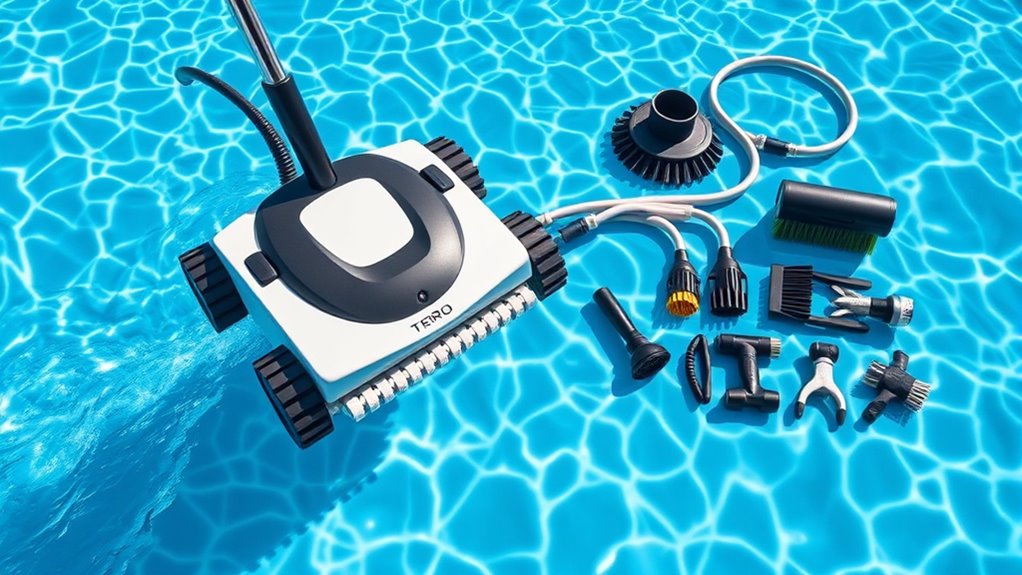
Using the correct cleaning accessories and settings is essential for maximizing your pressure pool cleaner’s efficiency. Choosing the appropriate nozzle selection ensures ideal water flow and cleaning power, reducing wear on your unit. Adjusting the correct cleaning frequency prevents overuse and unnecessary strain on components. To get the best results, consider these tips:
- Select nozzles suited for your pool’s size and debris level
- Use accessories designed for targeted cleaning, like brushes or scrubbers
- Set the cleaner to match your pool’s surface and debris load
- Regularly review and adjust the cleaning schedule based on pool conditions
- Incorporate maintenance requirements to prolong the lifespan and ensure optimal operation of your pressure pool cleaner. Additionally, understanding your equipment capabilities can help you fine-tune settings for better performance. Being aware of digital literacy programs and resources can also assist in troubleshooting and optimizing your device. Proper understanding of glamping practices and sustainable equipment options can further enhance your maintenance routine. Maintaining proper filter types and ensuring they are regularly cleaned can also significantly improve cleaning efficiency and extend your equipment’s lifespan.
Follow Manufacturer Guidelines for Maintenance
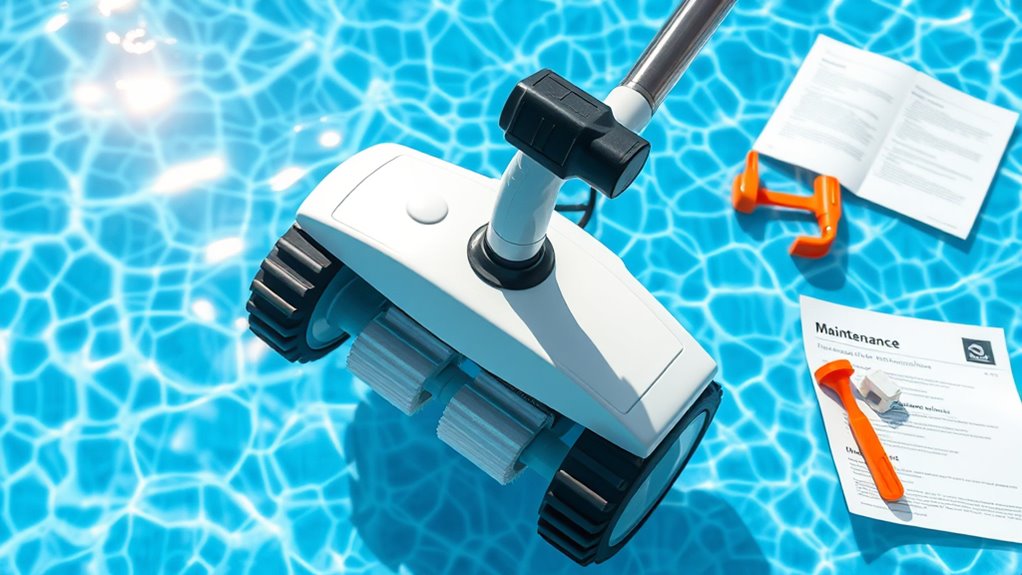
Following the manufacturer’s guidelines for maintenance is essential to keep your pressure pool cleaner operating effectively and avoid costly repairs. Always consult the manufacturer instructions for proper care, including routine calibration to guarantee maximum performance. Regularly inspecting parts and cleaning filters helps prevent buildup and wear. Keep a maintenance schedule based on the manufacturer’s recommendations to extend your cleaner’s lifespan. Use the table below to understand key maintenance tasks:
| Task | Frequency | Importance |
|---|---|---|
| Routine calibration | Monthly or as needed | Ensures proper operation |
| Filter cleaning | Weekly | Maintains suction efficiency |
| Inspect hoses and parts | Biweekly | Prevents leaks and damage |
| Check for debris | After use | Avoids motor strain |
Following these steps guarantees your pressure pool cleaner stays in top shape longer.
Frequently Asked Questions
How Often Should I Replace My Pressure Pool Cleaner’S Brushes?
You should replace your pressure pool cleaner’s brushes when you notice signs of wear or damage, typically every 6 to 12 months. Regular brush replacement is essential for maintaining peak cleaning performance. Keep an eye on the brushes during your routine cleaning and adjust your cleaning frequency based on pool usage and debris levels. Proper brush maintenance ensures your cleaner works efficiently and helps extend its overall lifespan.
What Are Signs My Cleaner Is Nearing the End of Its Lifespan?
Did you know that most pressure pool cleaners last around 3 to 5 years? To spot signs of wear, watch for decreased suction or uneven cleaning patterns. Motor issues like strange noises or frequent stops also indicate trouble. If you notice these signs, it’s time to contemplate replacing or repairing parts. Staying alert to these cues helps ensure your cleaner keeps working efficiently and extends its overall lifespan.
Can Using Harsh Chemicals Damage My Pressure Pool Cleaner?
Using harsh chemicals can cause chemical damage to your pressure pool cleaner, which may reduce its efficiency and overall longevity. When you expose your cleaner to strong chlorine, acids, or other aggressive substances, it can deteriorate internal parts and seals. To guarantee your cleaner lasts longer and works effectively, stick to manufacturer-recommended cleaning agents and avoid harsh chemicals that can compromise cleaner longevity, saving you money and hassle in the long run.
How Do I Troubleshoot if My Cleaner Isn’t Moving Properly?
Think of your pressure cleaner movement like a dancer’s rhythm—if one step falters, the whole performance suffers. For pool cleaner troubleshooting, first check the hoses for clogs or leaks, ensure the pressure valve is set correctly, and verify the skimmer and booster pump are working properly. If your cleaner still isn’t moving smoothly, inspect its brushes and tracks for debris or wear, then adjust or replace parts as needed.
Are There Eco-Friendly Maintenance Options for Prolonging Cleaner Life?
You’re wondering about eco-friendly tips for maintaining your pressure pool cleaner. Using sustainable maintenance practices, like regularly cleaning and inspecting parts with eco-safe solutions, helps prolong its life. Avoid harsh chemicals and opt for biodegradable detergents. Keep filters clean and store your cleaner properly when not in use. These eco-conscious steps lessen environmental impact and ensure your cleaner functions efficiently longer, saving you money and supporting sustainability.
Conclusion
By regularly inspecting and maintaining your pressure pool cleaner, you keep it running smoothly—like a well-oiled machine. Proper storage during off-season prevents damage, just like protecting your favorite gadget. Replacing worn parts ensures longevity, akin to changing tires on a car. While it takes a little effort, the payoff is a cleaner pool and fewer costly repairs. Think of maintenance as your pool’s best friend—keeping it happy and healthy, all season long.


